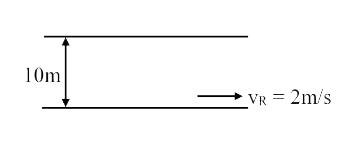A person can swim in still water at 5 m/s. He moves in a river of velocity 3 m/s. First down the stream next same distance up the steam the ratio of times taken are
1:1
1:2
1:4
4:1
The correct Answer is:C
To solve the problem step by step, we need to analyze the swimming speeds of the person in still water and in the river, both downstream and upstream.
Step 1: Define the given values
- Speed of the person in still water (V_person) = 5 m/s
- Speed of the river (V_river) = 3 m/s
Step 2: Calculate the effective speed downstream
When the person swims downstream, the effective speed (V_downstream) is the sum of the person's speed and the river's speed:
Vdownstream=Vperson+Vriver
Vdownstream=5m/s+3m/s=8m/s
Step 3: Calculate the effective speed upstream
When the person swims upstream, the effective speed (V_upstream) is the difference between the person's speed and the river's speed:
Vupstream=Vperson−Vriver
Vupstream=5m/s−3m/s=2m/s
Step 4: Define the distance
Let the distance the person swims downstream and upstream be d.
Step 5: Calculate the time taken for each journey
Using the formula for time, t=dv:
- Time taken to swim downstream (t1):
t1=dVdownstream=d8
- Time taken to swim upstream (t2):
t2=dVupstream=d2
Step 6: Find the ratio of times taken
Now, we find the ratio of the time taken upstream to the time taken downstream:
t2t1=d2d8
Cancelling d from the numerator and denominator:
t2t1=1/21/8=82=4
Step 7: Express the ratio in the required format
Thus, the ratio of times taken t1:t2 is:
t1:t2=1:4
Final Answer
The ratio of times taken to swim the same distance downstream and upstream is 1:4.
---
- Speed of the person in still water (V_person) = 5 m/s
- Speed of the river (V_river) = 3 m/s
When the person swims downstream, the effective speed (V_downstream) is the sum of the person's speed and the river's speed:
Vdownstream=Vperson+Vriver
Vdownstream=5m/s+3m/s=8m/s
When the person swims upstream, the effective speed (V_upstream) is the difference between the person's speed and the river's speed:
Vupstream=Vperson−Vriver
Vupstream=5m/s−3m/s=2m/s
Let the distance the person swims downstream and upstream be d.
Using the formula for time, t=dv:
- Time taken to swim downstream (t1):
t1=dVdownstream=d8
- Time taken to swim upstream (t2):
t2=dVupstream=d2
Now, we find the ratio of the time taken upstream to the time taken downstream:
t2t1=d2d8
Cancelling d from the numerator and denominator:
t2t1=1/21/8=82=4
Thus, the ratio of times taken t1:t2 is:
t1:t2=1:4
The ratio of times taken to swim the same distance downstream and upstream is 1:4.
Similar Questions
The velocity of a boat in still water is 10 m/s. If water flows in the river with a velocity of 6 m/s what is the difference in times taken to cross the river in the shortest path and the shortest time. The width of the river is 80 m.
View SolutionA man can swim in still water at 4m/s river is flowing at 2m/s. the angle with downstream at which he should swim to cross the river minimum drift is
View SolutionVelocity of boat in still water is 13 m/s. If water flows ina river with a velocity of 5 m/s. What is the difference in times taken by him to cross the river in the shortest path and in the shortest time. If the width of the river is 10 m.
View SolutionA man can swim in still water at a speed of 4 kmph. He desires to cross a river flowing at a speed of 3 kmph in the shortest time interval. If the width of the river is 3km time taken to cross the river (in hours) and the horizontal distance travelled (in km) are respectively
View SolutionA swimmer can swim in still water with speed v and the river is flowing with speed v/2. What is the ratio of the time taken to swimming across the river in shortest time to that of swimming across the river over the shortest distance ?
View SolutionThe speed of a swimmer in still water is 20 m//s. The speed of river water of river water is 10 m//s and due east. If he is standing on the south bank and wishes to cross the river along the shortest path the angle at which he should make his stroke w.r.t. noth is given by :-
View SolutionA boat moves in still water with a velocity which is k times less than the river flow velocity. Find the angle to the stream direction at which the boat should be rowed to minimize drifting.
View SolutionA boat moves in still water with a velocity which is k times less than the river flow velocity. Find the angle to the stream direction at which the boat should be rowed to minimize drifting.
View SolutionA river 500m wide is flowing at a rate of 4m/s. A boat is sailing at a velocity of 10m/s with respect to the water, in a direction perpendicular to the river. The time taken by the boat to reach the opposite bank
View SolutionA swimmer can swim in still water with a speed of 2.5 m/s. What is the shortest time taken by him to swim across the river?

View Solution
